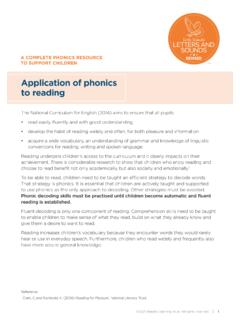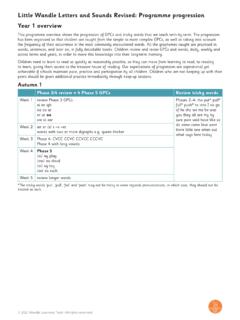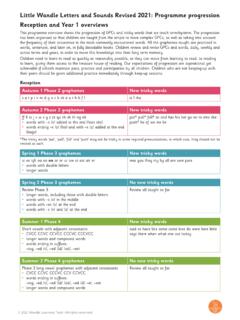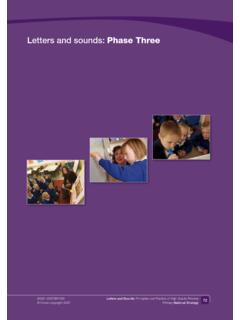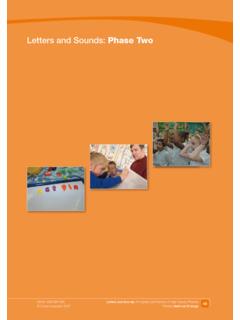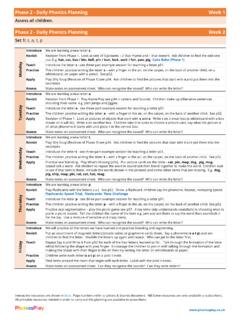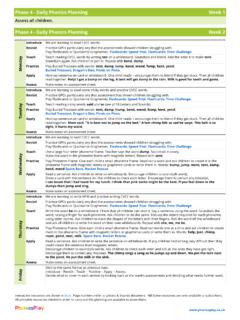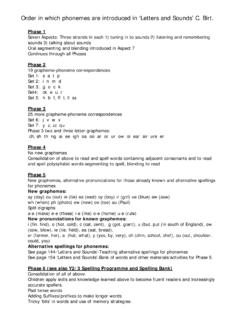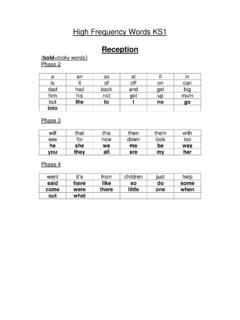Transcription of Guidance on selecting fully decodable books
1 1 2021 Wandle Learning Trust. All rights COMPLETE PHONICS RESOURCE TO SUPPORT CHILDRENG uidance on selecting fully decodable booksWhen children are learning to read, it is imperative that they practise independent reading with fully decodable books that are matched to their secure phonic knowledge. This will enable them to use the GPCs they know to decode the words and, with practise, develop fluency when reading. It will also establish the habit of using phonics as the route to decoding unknown words , avoiding unreliable guessing strategies. Evidence and experience clearly shows that this is the most effective approach to ensuring almost all children learn to read. When selecting books for independent reading practice, the following points are essential: The phonic progression of the decodable books must match the phonics progression of Little Wandle letters and sounds Revised.
2 The decodable books must introduce new GPCs in the same order as the teaching in Little Wandle letters and sounds Revised. The progression in the books must be cumulative, so children can practise the GPCs they have already learned in the programme. The tricky words must follow the progression for Little Wandle letters and sounds Revised, with each tricky word being taught before the children read a book containing it. Collins Big Cat for Little Wandle letters and sounds Revised have devised fully decodable books matched to our programme progression. In addition, there are many excellent schemes available from a range of commercial publishers. Some books that you may consider might follow the former letters and sounds programme. These could be labelled as phonic books , fully decodable , or linked to letters and sounds .
3 Detailed Guidance on selecting and organising suitable decodable books from your existing stock is provided in the Reading section of the , to be fully compatible with this programme, books need to specify that they follow Little Wandle letters and sounds 2021 Wandle Learning Trust. All rights books that: Make links to phonics, but are not fully decodable . They may have many decodable words mixed with other words (often referred to as context words ) that are not decodable at the children s phase of learning. This is a mixed approach and will not fully support the children s growing phonic knowledge. Are not decodable and use the whole language approach and the outdated searchlight approach (in which a repetitive structure is used to support the memorising of whole words , or that encourages guessing words from pictures or other context clues).
4 These methods are inefficient and do not support children effectively as their reading develops. Non- decodable books for sharingIn addition to practising their independent reading with decodable books , it is vital that children experience a wide range of other quality children s books that are either read to or with them. These books play an essential role in developing a love of reading. They can be shared or discussed, and provide a stimulus for other activities, including role play, music, art, dance, writing and storytelling. The important distinction is that these books are being shared with the children, but they are using fully phonically decodable books to practise their independent reading. 3 2021 Wandle Learning Trust. All rights to select fully decodable booksAdvice Notes Choose books that match the phonic progression of Little Wandle letters and sounds readers from different sources follow different phonic progressions.
5 In some instances, it may be possible to rearrange the book order to match the phonic progression of Little Wandle letters and sounds Revised. The new progression for Little Wandle letters and sounds Revised is provided in the updated material. Ensure that all teachers/teaching assistants know the phonic progression of Little Wandle letters and sounds books that have a cumulative phonic progression. Ensure the books review and practise GPCs from earlier phases as well as the GPCs the children are currently not choose books that contain GPCs the children have not been taught, for example, /ee/ for y in a book with Phase 3 assessing books , look for a chart that shows progression of the GPCs. Any books matched to phase 2 or 3 should not include adjacent consonants, except for plurals.
6 Children need to be introduced to blending words with adjacent consonants before they apply this to reading decodable books . This happens at Phase a series of books that gradually becomes more complex and longer in length and word count in the books should increase gradually a sudden increase will mean more cognitive load and could lead to diminished success. Ensure books include sentences (except for very early books ).In the earliest phases , the text in fully decodable books may not be in full sentences due to the limited number of graphemes covered. Children need to practise reading books with sentences as soon as possible. 4 2021 Wandle Learning Trust. All rights Notes Make sure the books practise a small number of the new tricky words from Little Wandle letters and sounds Revised.
7 Children need to practise these in context so they can become fluent readers. The tricky words must be words already taught in the Little Wandle letters and sounds Revised progression, and taught in the same order as the should be taught in the revisit and review part of the reading session before being practised in fully decodable books with too many tricky words , especially in the early phases . The number of tricky words should increase as children progress. The new progression for Little Wandle letters and sounds Revised is provided in the updated material. These are the new tricky words in Little Wandle letters and sounds Revised: phase 2 : is, I, the, put*, pull*, full*, as, and, has, his, her, go, no, to, into, she, push*, he, of, we, me, be Phase 3: was, you, they, my, by, all, are, sure, pure Phase 4: said, so, have, like, some, come, love, do, were, here, little, says, there, when, what, one, out, today Phase 5: their, people, oh, your, Mr, Mrs, Ms, ask*, our, could, would, should, house, mouse, water, want, any, many, again, who, whole, where, two, school, call, different, thought, through, friend, work, once, laugh, because, eye (*These words may not be tricky in some regional pronunciations.)
8 Do not use books that include non- decodable words , challenge/topic books are not fully decodable , and put unnecessary cognitive load on the children, which must be avoided. It is a priority that children practise reading words using their phonic knowledge, rather than remembering words or guessing them. 5 2021 Wandle Learning Trust. All rights Notes Choose high quality books which are engaging and link to the children s interests and the books progress, they must provide enough content and depth to support a range of comprehension challenges. It is important to invest in these books as they are the first books with which children practise their emerging reading books which are easy for a beginner reader to read and the early phases , avoid books with too many design features on a readability: look for clear font and uncluttered books which have a simple assessment that matches children s secure phonic knowledge to the correct for a chart that shows progression of GPCs so they can easily be matched to the new Little Wandle letters and sounds Revised that teachers/teaching assistants know the books well and can confidently match them to the children s secure phonic knowledge.
9 Children should be able to read the matched level of books at 90%+ fluency so they can transfer and apply their phonic knowledge whilst reading the 2021 Wandle Learning Trust. All rights books to children s secure phonic knowledge Matched books for Collins Big Cat for Little Wandle letters and sounds RevisedUse the termly assessments in conjunction with the Matching grid to match each child s secure phonic knowledge in reading words to the appropriate decodable reading book for the next six weeks. If children have not met the expected progress in the assessment, use the assessment from the previous term to establish their secure phonic knowledge when reading words . These children must have one-to-one additional daily support. Ensure they are re-assessed after three weeks to see if they are ready to move on.
10 If children are making quicker progress in between assessments, you can also use your judgement to move them on to the next level of book. Check the child can read: the GPCs in the book effortlessly the practice words at the front of the book fluently (with little or no overt blending) the tricky words . Now ask them to read the first double-page spread. Can they read it without hesitation? If so, then this book is the correct level. Autumn 1 Use wordless books to establish book behaviours, book talk and to grow vocabulary with small groups of children. Ensure all children who are not yet blending get additional blending practice in this session. From week 3 or 4 onwards, some children in Reception will be ready to practise reading books before the first assessment.
